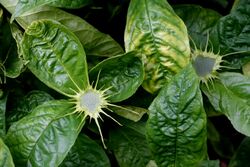Biology:Dorstenia barteri
| Dorstenia barteri | |
|---|---|

| |
| Dorstenia barteri var. multiradiata | |
| Scientific classification | |
| Kingdom: | Plantae |
| Clade: | Tracheophytes |
| Clade: | Angiosperms |
| Clade: | Eudicots |
| Clade: | Rosids |
| Order: | Rosales |
| Family: | Moraceae |
| Genus: | Dorstenia |
| Species: | D. barteri
|
| Binomial name | |
| Dorstenia barteri Bureau
| |
Dorstenia barteri is a West African plant species belonging to the family Moraceae.
Description
A herb, 60 cm high, with a creeping rooting base. Stem erect, somewhat fleshy, subflexuous, pubescent to tomentose in the upper portion, up to 5 cm thick in the lower portion. Leaves papery when dry, obovate-elliptic to elliptic, shortly acuminate, narrowing to an obtuse base, margin entire or wavy, 14–18 cm long, 5–8 cm wide, glabrous, paler green beneath; lateral nerves 8–10 on each side, curving upwards and uniting within the margin, prominent beneath; petiole more or less pubescent, about 1.2 cm or less in length. Stipules subulate, 5–6 cm or less in length, generally falling before the leaves. Inflorescence solitary in the upper leaf-axils; stalk 1.2– 2 cm long, puberulous; receptacle flattened or somewhat convex, orbicular, 2.5–4.5 cm in diameter, including the broad membranous margin (7–10 cm wide), which is prolonged into numerous (about 15) very unequal bract-arms, a few from 1.2– 2 cm long, the remainder short, from 2.5–7.5 cm long. Flowers very distinct. Male flowers 3-merous, the 3 bluntly rounded perianth-lobes depressed on the surface of the disc. Female perianth ring-like, raised above the disc-surface, the deeply 2-fid style projecting from the mouth. Endocarp of fruit subglobose, smooth, whitish brown, 4 cm in diameter.[1]
Medicinal uses
Dorstenia barteri is used in West African folk medicine. It contains numerous flavonoid compounds that have anti-microbial, anti-reverse transcriptase, and anti-inflammatory effects.[2][3]
References
- ↑ Hutchinson, J. & Rendle, A. B. Flora of Tropical Africa, Vol 6, Part 2, 1916: 17.
- ↑ Kuete, V.; Ngameni, B.; Mbaveng, A.T.; Ngadjui, B.; Meyer, J.J. Marion; Lall, N. (2010). "Evaluation of flavonoids from Dorstenia barteri for their antimycobacterial, antigonorrheal and anti-reverse transcriptase activities". Acta Tropica 116 (1): 100–104. doi:10.1016/j.actatropica.2010.06.005. ISSN 0001-706X. PMID 20599632.
- ↑ Omisore, N.O.A.; Adewunmi, C.O.; Iwalewa, E.O.; Ngadjui, B.T.; Watchueng, J.; Abegaz, B.M.; Ojewole, J.A.O. (2004). "Antinociceptive and anti-inflammatory effects of Dorstenia barteri (Moraceae) leaf and twig extracts in mice". Journal of Ethnopharmacology 95 (1): 7–12. doi:10.1016/j.jep.2004.05.022. ISSN 0378-8741. PMID 15374600.
Wikidata ☰ Q15471603 entry
 |

